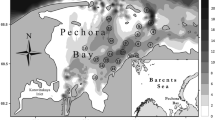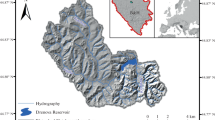Abstract
Amphipods-oligochaetes index has been developed for the assessment of the state of macrozoobenthos in deep-water areas of Lake Onega. By the value of this index, bed areas of Petrozavodsk Bay, which are subject to the effect of municipal wastewaters, tank farm, rivers within the city boundaries, and the Shuya R., a large tributary of Lake Onega, show a high degree of transformation of zoobenthos community and highest pollution. The ratios of the major zoobenthos groups (amphipods and oligochaetes) in the central part of Petrozavodsk Bay and on its northern shore is at the natural level, but their abundance is dozens of times greater than that in background areas of Lake Onega. A reliable correlation was found to exist between the values of amphipods-oligochaetes index and the redox potential of the top layer of bottom sediments.
Similar content being viewed by others
References
Abakumov, V.A., Ecological modifications and development of biocenoses, in Ekologicheskie modifikatsii i kriterii ekologicheskogo normirovaniya (Ecological Modifications and Criteria of Environmental Standardization), Leningrad: Gidrometeoizdat, 1991, pp. 18–41.
Antropogennoe evtrofirovanie Ladozhskogo ozera (Anthropogenic Eutrophication of Lake Ladoga), Petrova, N.A., Ed., Leningrad: Nauka, 1982.
Arinushkina, E.V., Rukovodstvo po khimicheskomu analizu pochv (Guide for Chemical Analysis of Soils), Moscow: Izd. MGU, 1961.
Bakanov, A.I., The use of zoobenthos for monitoring freshwater bodies: A review, Biol. vnutr. vod, 2000, no. 1, pp. 68–82.
Belkina, N.A., Lake Onega and its tributaries, in Sostoyanie vodnykh ob“ektov Respubliki Kareliya (po rezul’tatam monitoringa 1998–2006 gg.) (The State of Water Bodies in the Republic of Karelia (Based on Monitoring Results)), Petrozavodsk: Izd. KarNTs RAN, 2007, pp. 41–49.
Ivanter, E.V., and Korosov, A.V., Vvedenie v kolichestvennuyu biologiyu (Introduction to Quantitative Biology), Petrozavodsk: Izd. PetrGU, 2003.
Kalinkina, N.M., and Kulikova, T.P., Evolutioninduced response of aquatic organisms to changes in water ionic composition: case study of freshwater zooplankton, Izv. Akad. Nauk, Ser. Biol., 2009, no. 2, pp. 243–248.
Kaufman, Z.S., and Polyakova, T.N., Benthic fauna, in Ekosistema Onezhskogo ozera i tendentsii ee izmeneniya (Ecosystem of Lake Onega and Trends in Its Variations), Leningrad: Nauka, 1990, pp. 216–230.
Lifshits, V.Kh., Brief physico-geographic characteristic and some elements of the hydrological regime of Petrozavodsk Bay, in Gidrobiologiya Petrozavodskoi guby Onezhskogo ozera (Hydrobiology of Petrozavodsk Bay, Lake Onega), Petrozavodsk: Izd. KF AN SSSR, 1980, pp. 5–10.
Metodicheskie rekomendatsii po sboru i obrabotke materialov pri gidrobiologicheskikh issledovaniyakh na presnovodnykh vodoemakh. Zoobentos i ego produktsiya (Methodological Recommendations for Collection and Processing of Materials in Hydrobiological Studies in Freshwater Bodies: Zoobenthos and Its Production), Leningrad: Izd. GosNIORKh, 1984.
Onezhskoe ozero. Ekologicheskie problemy (Lake Onega: Environmental Problems), Filatov, N.N., Ed., Petrozavodsk: Izd. KarNTs RAN, 1999.
RD 52.24.309-92. Organizatsiya i provedenie rezhimnykh nablyudenii za zagryazneniem poverkhnostnykh vod sushi na seti Roskomgidrometa. Metodicheskie ukazaniya. Okhrana prirody. Gidrosfera (RD 52.24.309-92. Organization and Implementation of Regular Observations of Pollution of Surface Continental Waters in Roshydromet Network. Methodological Guides. Nature Protection. Hydrosphere), St. Petersburg: Gidrometeoizdat, 1992.
Ryabinkin, A.V., and Polyakova, T.N., Lake macrozoobenthos and its role in fish nutrition, in Bioresursy Onezhskogo ozera (Lake Onega Bioresources), Petrozavodsk: Izd. KarNTs RAN, 2008.
Sabylina, A.V., Lake Onega and its tributaries: Water chemistry in tributaries, in Sostoyanie vodnykh ob“ektov Respubliki Kareliya (po rezul’tatam monitoringa 1998–2006 gg.) (The State of Water Bodies in the Republic of Karelia (Based on 1998–2006 Monitoring), Petrozavodsk: Izd. KarNTs RAN, 2007, pp. 21–29.
Shitikov, V.K., Rozenberg, G.S., and Zinchenko, T.D., Kolichestvennaya gidroekologiya: metody, kriterii, resheniya (Quantitative Hydroecology: Methods, Criteria, Solutions), Moscow: Nauka, 2005, vol. 2.
Belkina, N.A., Chemical composition of sediments, Analytical and Sampling Methods for Environmental Monitoring in Lake Ladoga and Other Large Lakes in Russia. Joensuu, 1999, vol. 3, pp. 18–21.
Author information
Authors and Affiliations
Corresponding author
Additional information
Original Russian Text © N.M. Kalinkina, N.A. Belkina, T.N. Polyakova, M.T. Syarki, 2013, published in Vodnye Resursy, 2013, Vol. 40, No. 5, pp. 488–495.
Rights and permissions
About this article
Cite this article
Kalinkina, N.M., Belkina, N.A., Polyakova, T.N. et al. Bioindication of the state of deep-water areas in Petrozavodsk Bay, Lake Onega, by macrozoobenthos characteristics. Water Resour 40, 528–534 (2013). https://doi.org/10.1134/S0097807813050047
Received:
Published:
Issue Date:
DOI: https://doi.org/10.1134/S0097807813050047




